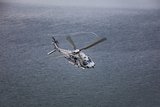Navy pilots train for Helmand in Californian desert
Royal Navy Sea King helicopter pilots and their crews from the Commando Helicopter Force (CHF) have been training for their deployment to Afghanistan in the Californian desert.
The pilots and aircrew from 845 and 846 Naval Air Squadrons have been undergoing environmental qualification training at the Naval Air Facility El Centro, just north of the Mexican border.
The purpose of this training, called Exercise Desert Commando, has been to refresh some of the older pilots and aircrew of the CHF in the techniques required to operate in the harsh conditions of the desert which are similar to those they will face in Helmand.
At the same time, personnel fresh to the front line are getting their first taste of what it is like to work in this environment.
Although many of the techniques are the same as taught and practised during Sea King flying training, there are small differences, and some big ones.
For the pilots and aircrew who have never worked in this environment before, one of the most notable differences is the temperature. Constantly sweating in the aircraft is not a strange phenomenon to the new pilots because during training their instructors certainly knew how to make them work hard. However, for this exercise, constant perspiration in the cockpit was due to the baking California sun.
It is not just the aircrew who have faced increased physical demands - the engineers worked tirelessly ensuring the venerable old Sea King was serviceable for the training flights.
The engineers rose admirably to the challenges presented by the need to change engines, fuel tanks and radios - without their commitment and dedication to maintaining the aircraft it would not have been possible to meet the required training objectives.
Most of the training was conducted at New Holtsville - a disused airfield 15 minutes flight from El Centro which was suitable for perfecting dust landings and load-lifting.
To assist with this, the mobile air operations team was despatched from Yeovilton to spend many an hour in the harsh sun setting up aids on the ground used by the pilots to land the aircraft in dust recirculation, and to assist with the load-lifting serials.
During the training exercises, Rear Admiral Tony Johnstone-Burt, Commander of Joint Helicopter Command, made a visit to observe how the men and women of the CHF were operating. He said:
"The Royal Navy's Commando Helicopter Force contributes significantly to the stabilisation effort in Afghanistan.
"I have been enormously impressed by all the personnel involved, both during their training and when deployed on operations.
"Our aircrew, ground crew and engineers and their helicopters in theatre are doing amazing things in extreme temperatures and in the face of a very determined enemy.
"Exercise Desert Commando has afforded our aircrew environmental training which is vital for their preparation for their squadrons' deployment to Helmand later in the year."
Overall, 25 aircrew flew more than 130 hours during the environmental flying course. All the training objectives were achieved which means that everyone now has the skills necessary to face up to the challenges of working in Afghanistan in the not too distant future.
Source: Ministry of Defence
More from Defence Helicopter
-
![Germany to send WS-61 Westland Sea King helicopters to Ukraine]()
Germany to send WS-61 Westland Sea King helicopters to Ukraine
Germany has committed to sending Ukraine six of its 21 retiring WS-61 Westland Sea King multirole, amphibious helicopters.
-
![Boeing secures $271 million to advance modernisation of US Special Operations' MH-47G Chinook]()
Boeing secures $271 million to advance modernisation of US Special Operations' MH-47G Chinook
Boeing has clinched a major contract modification to further its backing of the US Special Operations Command’s MH-47G Chinook aircraft modernisation effort.
-
![Dubai Airshow 2023: South Korean homegrown helicopters make international debut]()
Dubai Airshow 2023: South Korean homegrown helicopters make international debut
Two KAI helicopters, the KUH-1E utility helicopter and the Light Attack Helicopter (LAH), have taken centre stage at the Dubai Airshow 2023.
-
![Italian Navy receives final NH90 helicopter]()
Italian Navy receives final NH90 helicopter
The Italian Navy now boasts a fleet of 56 NH90 helicopters comprising 46 SH-90As and 10 MH-90As.
-
![Argentina seeks AW109 and CH-46 Sea Knight helicopters]()
Argentina seeks AW109 and CH-46 Sea Knight helicopters
The Argentinian Air Force (FAA) and the Argentinian Naval Aviation Command (COAN) are looking for options to upgrade their helicopter fleets.
-
![DSEI 2023: Lockheed to produce about 40% of Black Hawks on UK soil if it wins NMH contest]()
DSEI 2023: Lockheed to produce about 40% of Black Hawks on UK soil if it wins NMH contest
Lockheed Martin promises a boost to the British job market and export opportunities, while strengthening ties with Poland and positioning the UK for a future in rotorcraft technology in the event of a New Medium Helicopter competition triumph.


























